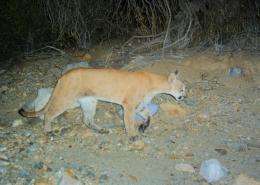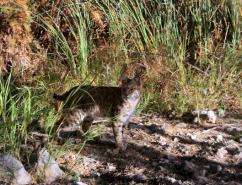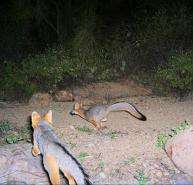Wild cats roam the Tucson Mountains

(PhysOrg.com) -- For the first time, mountain lions and bobcats have been photographed as part of an in-depth monitoring study in the Tucson Mountains, a small island of habitat facing increasing segregation from surrounding natural areas because of urban sprawl and road construction.
Using infrared-triggered cameras at 65 sites, UA researchers captured 36 photographs of mountain lions roaming the Tucson Mountains. The study confirmed that lions in at least two age groups – adults and almost-grown kittens – use the Tucson Mountains as either their home range or are in transit.
"We have established that there are mountain lions in the Tucson Mountains, and they have been there fairly consistently over time," said Lisa Haynes, a researcher with the Wild Cat Research Conservation Program at the UA's School of Natural Resources and the Environment.
Not only did the study confirm the presence of mountain lions, it detected other wildlife including bobcats, deer, gray foxes and ringtails. While the team was able to identify specific bobcats in the snapshots based on their unique pattern of fur spots, the photographs did not allow for the identification of individual mountain lions.
"In a subset of 21 lion photos from a three-month period in 2009, we identified, at most, an adult female, a young female, a young male and a subadult male," the authors wrote in their final report. However, because males and females are very difficult to distinguish in pictures, all the researchers know for sure is that there are two age classes, adults and subadults.

Subadults are almost-grown kittens that are newly independent of their mother. They can be distinguished by very faint spots on their fur, which disappear as they approach adulthood.
"Unfortunately, you cannot tell individual mountain lions apart by the photographs. They almost all look alike, so in most cases, you have the same individuals walking in front of the camera multiple times," Haynes explained.
Urban sprawl threatens habitat
An important goal of the study was to assess whether the mountain lions call the Tucson Mountains their primary home range or whether they migrate along wildlife corridors.
To detect migrating lions, the group monitored potential wildlife corridors surrounding the Tucson Mountains, including the designated wildlife crossings of the Central Arizona Project canal. None of those camera sites photographed mountain lions, but bobcats and a variety of other wildlife.
"Although we were not able to document mountain lions moving in or out of the Tucson Mountains, the fact that two wild cat species still exist in the Tucson Mountains is testament to its ecological value in this remarkable and diverse bioregion," Haynes said.
But she added a word of caution, too: "The Tucson Mountain area is a template for what will happen to larger mountain ranges and habitat patches in the future as sprawl increases."
Why we need mountain lions
Using infrared cameras set off by a passing animal triggering a motion sensor, Haynes' group obtained more than 12,000 photos during the project, most of which were taken in the interior of the Tucson Mountains. The team of co-workers and volunteers took on the task of checking the cameras and processing the thousands of photos.
"Only 36 of those photos showed mountain lions," Haynes said. "That just tells you the number of photos we would need to document their movements in the corridors. We would have to set up cameras in a much higher density. A mountain lion could still have made it through a corridor without a camera picking it up, because the cameras only capture what goes on within about 15 feet."

Limited resources and permitting issues prevented the team from setting up cameras in the most promising corridor spots for very long. "We only had a six-month period in some of the best locations," Haynes said.
Urban sprawl, road construction and other infrastructure developments such as the Central Arizona Project Canal threaten to cut the mountain lions' habitat into smaller and smaller fragments. Trapped in a shrinking habitat and with migratory routes interrupted, the animals are at high risk from inbreeding and even local extinction.
"In an ideal situation, you have resident adults and interchange with juvenile animals coming through from outside areas," Haynes said.
According to the study, the mountain lion population in this area is already facing greater geographic constriction than other lion populations deemed genetically isolated and ultimately unlikely to survive. If a top carnivore such as the mountain lion becomes locally extinct, it can have detrimental effects on the ecosystem. Overpopulation of deer is a likely result, in turn leading to overbrowsing of native vegetation.
Mountain lions depend on large swaths of land to survive and form a healthy population, Haynes said.
"Typically in the Southwest, a resident adult male has a home range anywhere from 30 to 120 square miles. If they have to ‘island-hop' between mountain ranges, it could be up to 400 square miles. The males do not get along with each other. They will mark their territory and communicate that way to stay out of each other's way. But if they do come across each other, they often will fight, sometimes to the death."
According to Haynes, the home ranges of female lions overlap a lot more, and females are much more tolerant of each other.
"A male home range may encompass, say, four to five female home ranges, and he may be the breeding male," she said. "The females can have kittens all year round, but there is usually a spike in the spring, when they have a lot of prey available to them, fawns for example."
Life as a cougar kitten
The female gives birth to one to four kittens, only one or two of which usually survive. For the first 11 to 18 months, the mother stays with her kittens.
"She teaches them how to hunt and how to survive," Haynes said. "But once they're subadults, they're on their own."
In areas where the population does not experience a lot of stress, a mountain lion can live up to 12 years. Despite facing intensive pressure from relentless persecution in first half of the 1900s and modern pressures such as habitat fragmentation and destruction, mountain lions are a remarkably resilient species that has managed to endure from Alaska all the way to the tip of South America.
"Mountain lions are a very successful species because enough kittens are being born and enough females get it figured out to raise them safely to young adulthood," Haynes said. "The males basically live for two things: access to females and checking out the other guys and making sure they're not coming in. Food is not a big deal in most habitats. For them, it's like going to the Circle K. They can get a deer or a javelina if they want. Hunting is just something that they do."
"Sometimes kittens and subadults may not survive, but those adults are pretty good at what they're doing."
Although the cameras were distributed throughout the Tucson Mountains, mountain lions were only photographed in the backcountry, not near residential areas, and most of the lion photographs were triggered at night, exemplifying the mountain lions' natural tendency to avoid humans.
Human barriers prevent migration
"From our study, we can't say whether the mountain lions we photographed are residents or not. If they do move in and out or through the Tucson Mountains, the mountain ranges to the west are the most likely ones to serve as their interconnected population habitats. It is less likely that cats can move to the east, north or south, due to urban-related barriers," Haynes said.
"There is a range of possible conclusions. It could be anything from, ‘these cats are just transients coming from the surrounding areas, or they live solely on the mountain essentially being trapped, or there still is a mix of residents and transients, which would be ideal.'"
"The Sonoran Desert Conservation Plan calls for the conservation of critical wildlife corridors throughout Pima County. The only way to fully identify the corridors that mountain lions use, would be to radio collar the cats. That is something that we as a community should decide after weighing the risks and benefits," she added.
Provided by University of Arizona

















